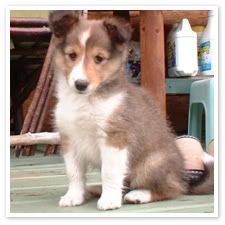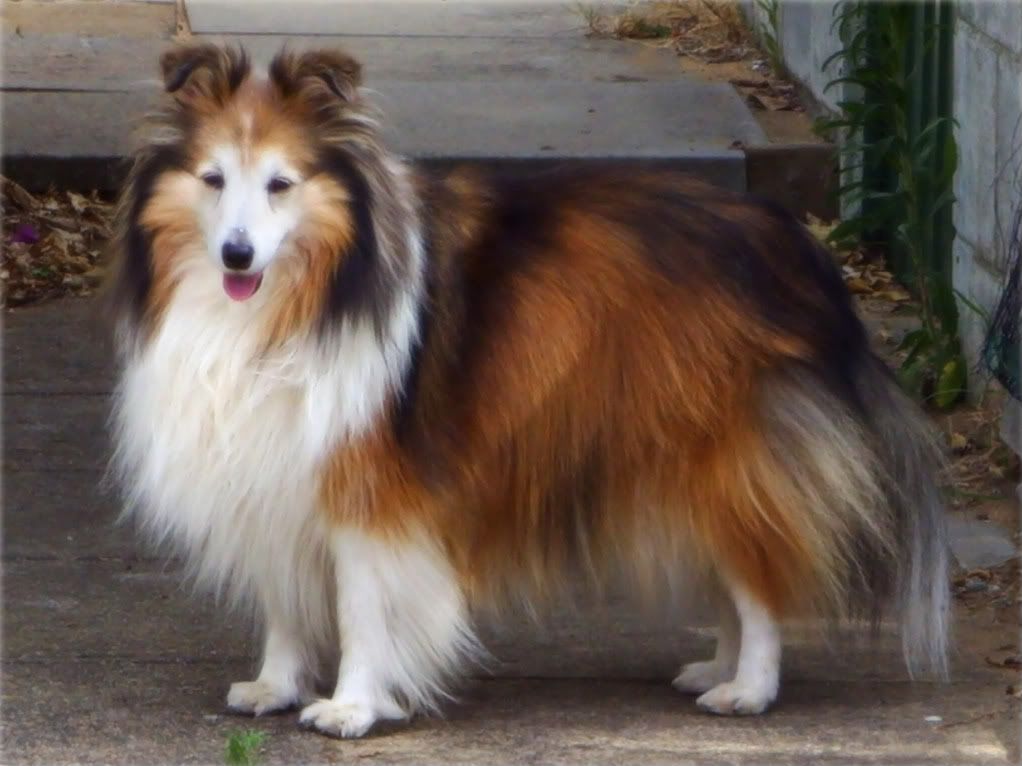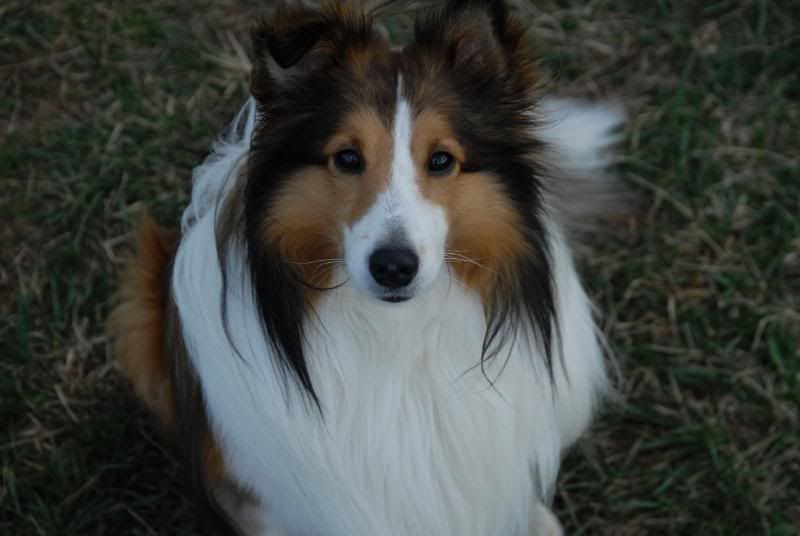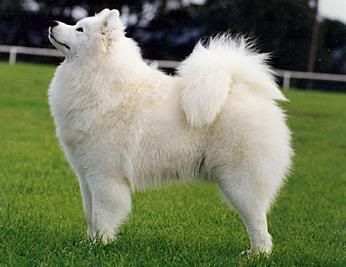Oh my god.. I wanna have a puppy
But my mum just won't allow ever since young.
So now, me and my brother thought of just buying a dog regardless if me mom allows us..
The most, we will get chase out of house with the puppy.
We are planning where can i stay if i got chased out.
Dogs are extremely cute i wish i can have a puppy as me birthday present please..
Went to pasir ris farm way with my brother on yesterday's evening. It's a so last min thing that we decided to go. Japanese Spitz, Long hair chihuahua, husky or Shetland Sheepdog!
My brother would want a Rottweiler if there it and my father likes Doberman dog..
There will be Doberman puppies coming in next 2 months. So gonna see them.
Saw a very huge dog..Tibetan Mastiff. Taller than me if he stands up. Head is bigger than mind and it cost 15k.
Shetland Sheepdog




Temperament
The Shetland sheepdog is lively, intelligent, playful, trainable, and willing to please and obey. They are loving, loyal, and affectionate with their family, but are naturally aloof with strangers; for this reason Shelties must be socialized. The Shetland Sheepdog Standard from the AKC allows them to be reserved to strangers, but they should not show fear. Shelties do well with children if they are reared with them from an early age; however, their small size makes it easy for a child to accidentally injure them, so supervision is necessary. Shelties are vocal dogs.The average Sheltie is an excellent watch dog.
Health
For the most part, Shelties are athletic and healthy. Like the Rough Collie, there is a tendency toward inherited malformation and disease of the eyes. Each individual puppy should have his eyes examined by a qualified veterinary ophthalmologist. Some lines may be susceptible to hypothyroidism, epilepsy, hip dysplasia, or skin allergies. The usual life span for Shelties is between 10 and 15 years.
Shelties are also highly susceptible to Transitional Cell Carcinoma (TCC). TCC is a cancer of the bladder, and can be diagnosed early by regular urinalysis from a normal veterinarian. Causes are debated between breed susceptibility and female gender and exposure to insecticides.
Dermatomyositis may occur at the age of 4 to 6 months, and is frequently misdiagnosed by general practice veterinarians as sarcoptic or demodectic mange. The disease manifests itself as alopecia on the top of the head, supra- and suborbital area and forearms as well as the tip of the tail. If the disease progresses to its more damaging form, it could affect the autonomic nervous system and the dog may have to be euthanised. This disease is generation-skipping and genetically transmitted, with breeders having no clear methodology for screening except clear bloodline records. Deep tissue biopsies are required to definitively diagnose dermatomyositis.
Japanese Spitz


Temperament
Active, loyal, and bright, the Japanese Spitz are known for their great courage, affection and devotion making them great watchdogs and ideal companions for older people and small children. Most Japanese Spitz are good watch dogs and they have a tendency to bark to warn off arriving strangers. The Japanese Spitz is first and foremost a companion dog and thrives on human contact and attention, preferring to be a member of the family. They are known as very loyal dogs. Despite their relatively small size, they are brave and consider it their duty to protect their family. They enjoy being active and love to be in the outdoors.They are intelligent, playful, alert, and obedient, and particularly excellent and loving toward children.
Life expectancy is estimated at 12-16 years.
Health
A Japanese Spitz puppy. They are a healthy breed with very few genetic problems. The main health concern for Japanese Spitz is the development of Patellar luxation, a condition in which the kneecap dislocates out of its normal position. They can also be prone to runny eyes, which is most commonly due to having tear ducts that are too small, or an allergy to long grass or stress. It is rarely caused by any serious eye defect.
Samoyed




Samoyeds' friendly disposition makes them poor guard dogs; an aggressive Samoyed is rare. With their tendency to bark, however, they can be diligent watch dogs, barking whenever something approaches their territory. Samoyeds are excellent companions, especially for small children or even other dogs, and they remain playful into old age. When Samoyeds become bored they may begin to dig. With their sled dog heritage, a Samoyed is not averse to pulling things, and an untrained Samoyed has no problem pulling its owner on a leash rather than walking alongside. Samoyeds were also used to herd reindeer. They will instinctively act as herd dogs, and when playing with children, especially, will often attempt to turn and move them in a different direction. The breed is characterized by an alert and happy expression which has earned the nicknames "Sammy smile" and "smiley dog
Samoyeds can be affected by a genetic disease known as "Samoyed Hereditary Glomerulopathy", a renal disease. The disease is known to be caused by an X-linked dominant faulty allele and therefore the disease is more severe in male Samoyeds.[5] Carrier females do develop mild symptoms after 2–3 months of age, but mostly[6] do not go on to develop renal failure. The disease is caused by a defect in the structure of the type-IV collagen fibrils of the glomerular basement membrane. As a consequence, the collagen fibrils of the glomerular basement membrane are unable to form cross-links, so the structural integrity is weakened and the membrane is more susceptible to "wear-and-tear" damage. As the structure of the basement membrane begins to degenerate, plasma proteins are lost in the urine and symptoms begin to appear. Affected males appear healthy for the first 3 months of life, but then symptoms start to appear and worsen as the disease progresses: the dog becomes lethargic and muscle wastage occurs, as a result of proteinuria. From 3 months of age onwards, a reduced glomerular filtration rate is detected, indicative of progressive renal failure. Death from renal failure usually occurs by 15 months of age.
Also known as Hereditary nephritis, it is caused by a nonsense mutation in codon 1027 of the COL4A5 gene on the X chromosome (glycine to stop codon), which is similar to Alport's syndrome in humans. The disease is simply inherited X-linked dominant, with males generally having more severe symptoms than females. Clinically, proteinuria is found in both sexes from the age of three to four months; in dogs older than this, renal failure in combination with more or less pronounced hearing loss occurs swiftly and death at the age of 8 to 15 months is expected. In heterozygous females, the disease develops slowly. The disease can be treated to slow down the development by use of cyclosporine A and ACE inhibitors, but not be stopped.
As yet there is no genetic screening test available for Samoyed Hereditary Glomerulopathy. If a carrier female is mated with a healthy stud dog, the female offspring have a 50% chance of being carriers for the disease, and any male offspring have a 50% chance of being affected by the disease.
Chihuahua
TemperamentA Chihuahua must be chosen with care, as the temperament of its owner can make a difference in the temperament of the pup. Ill tempered Chihuahuas can be easily provoked to attack, and are therefore generally unsuitable for homes with small children. The breed tends to be fiercely loyal to one particular owner and in some cases may become over protective of the person, especially around other people or animals. They do not always get along with other breeds and tend to have a "clannish" nature, often preferring the companionship of other Chihuahuas over other dogs. These traits generally make them unsuitable for households with children that are not patient and calm. Chihuahuas love their dens and will often burrow themselves in pillows, clothes hampers, and blankets. They are often found under the covers or at the bottom of the bed, deep in the dark and safety of what they believe is their den.
Health disorders
This breed requires expert veterinary attention in areas such as birthing and dental care. Chihuahuas are also prone to some genetic anomalies, often neurological ones, such as epilepsy and seizure disorders.
Chihuahuas, and other toy breeds, are prone to the sometimes painful disease hydrocephalus. It is often diagnosed by the puppy having an abnormally large head, or hydrocephalus, during the first several months of life, but other symptoms are more noticeable since "a large head" is such a broad description. Chihuahua puppies exhibiting hydrocephalus usually have patchy skull plates rather than a solid bone and typically are lethargic and do not grow at the same pace as their siblings. A true case of hydrocephalus can be diagnosed by a veterinarian, though the prognosis is grim.
Chihuahuas have moleras, or a soft spot in their skulls, and they are the only breed of dog to be born with an incomplete skull. The molera fills in with age, but great care needs to be taken during the first six months until the skull is fully formed. Some moleras do not close completely and will require extra care to prevent injury. Many veterinarians are not familiar with Chihuahuas as a breed and mistakenly confuse a molera with hydrocephalus.
Chihuahuas can also be at risk for hypoglycemia, or low blood sugar, which is especially dangerous for puppies. Left unattended, hypoglycemia can lead to coma and death but can be avoided with frequent feedings, such as every three hours for very small or young puppies. Chihuahua owners should have a simple sugar supplement on hand to use in emergencies, such as, Nutri-Cal, Karo syrup or honey. These supplements can be rubbed on the gums and roof of the mouth to rapidly raise the blood sugar level. Signs of hypoglycemia include lethargy, sleepiness, low energy, uncoordinated walking, unfocused eyes and spasms of the neck muscles or head pulling back or to the side.
Chihuahuas are prone to eye infections or eye injury due to their large, round, protruding eyes and their relatively low ground clearance. Care should be taken to prevent visitors or children from poking the eyes. The eyes also water frequently to remove dust or allergens that may get into the eye. Daily wiping will keep the eyes clean and prevent tear staining.
Collapsed trachea (reverse sneezing) is a health concern that is characteristic of the chihuahua breed.
Chihuahuas have a tendency to tremble but it is not a health issue. Instead, it occurs mainly when the dog is stressed, excited or cold. Cold can also present a problem for these small animals. They often enjoy wearing coats or sweaters when outside and enjoy digging and snuggling in blankets when sleeping.
Although figures often vary, as with any breed, the average lifespan range for a healthy Chihuahua is between 10 and 17 years.
All dogs are so cute..
But really afraid that they will have health problems..
Because all that will make me feel depressed.
But my mum just won't allow ever since young.
So now, me and my brother thought of just buying a dog regardless if me mom allows us..
The most, we will get chase out of house with the puppy.
We are planning where can i stay if i got chased out.
Dogs are extremely cute i wish i can have a puppy as me birthday present please..
Went to pasir ris farm way with my brother on yesterday's evening. It's a so last min thing that we decided to go. Japanese Spitz, Long hair chihuahua, husky or Shetland Sheepdog!
My brother would want a Rottweiler if there it and my father likes Doberman dog..
There will be Doberman puppies coming in next 2 months. So gonna see them.
Saw a very huge dog..Tibetan Mastiff. Taller than me if he stands up. Head is bigger than mind and it cost 15k.
Shetland Sheepdog




Temperament
The Shetland sheepdog is lively, intelligent, playful, trainable, and willing to please and obey. They are loving, loyal, and affectionate with their family, but are naturally aloof with strangers; for this reason Shelties must be socialized. The Shetland Sheepdog Standard from the AKC allows them to be reserved to strangers, but they should not show fear. Shelties do well with children if they are reared with them from an early age; however, their small size makes it easy for a child to accidentally injure them, so supervision is necessary. Shelties are vocal dogs.The average Sheltie is an excellent watch dog.
Health
For the most part, Shelties are athletic and healthy. Like the Rough Collie, there is a tendency toward inherited malformation and disease of the eyes. Each individual puppy should have his eyes examined by a qualified veterinary ophthalmologist. Some lines may be susceptible to hypothyroidism, epilepsy, hip dysplasia, or skin allergies. The usual life span for Shelties is between 10 and 15 years.
Shelties are also highly susceptible to Transitional Cell Carcinoma (TCC). TCC is a cancer of the bladder, and can be diagnosed early by regular urinalysis from a normal veterinarian. Causes are debated between breed susceptibility and female gender and exposure to insecticides.
Dermatomyositis may occur at the age of 4 to 6 months, and is frequently misdiagnosed by general practice veterinarians as sarcoptic or demodectic mange. The disease manifests itself as alopecia on the top of the head, supra- and suborbital area and forearms as well as the tip of the tail. If the disease progresses to its more damaging form, it could affect the autonomic nervous system and the dog may have to be euthanised. This disease is generation-skipping and genetically transmitted, with breeders having no clear methodology for screening except clear bloodline records. Deep tissue biopsies are required to definitively diagnose dermatomyositis.
Japanese Spitz


Temperament
Active, loyal, and bright, the Japanese Spitz are known for their great courage, affection and devotion making them great watchdogs and ideal companions for older people and small children. Most Japanese Spitz are good watch dogs and they have a tendency to bark to warn off arriving strangers. The Japanese Spitz is first and foremost a companion dog and thrives on human contact and attention, preferring to be a member of the family. They are known as very loyal dogs. Despite their relatively small size, they are brave and consider it their duty to protect their family. They enjoy being active and love to be in the outdoors.They are intelligent, playful, alert, and obedient, and particularly excellent and loving toward children.
Life expectancy is estimated at 12-16 years.
Health
A Japanese Spitz puppy. They are a healthy breed with very few genetic problems. The main health concern for Japanese Spitz is the development of Patellar luxation, a condition in which the kneecap dislocates out of its normal position. They can also be prone to runny eyes, which is most commonly due to having tear ducts that are too small, or an allergy to long grass or stress. It is rarely caused by any serious eye defect.
Samoyed




Samoyeds' friendly disposition makes them poor guard dogs; an aggressive Samoyed is rare. With their tendency to bark, however, they can be diligent watch dogs, barking whenever something approaches their territory. Samoyeds are excellent companions, especially for small children or even other dogs, and they remain playful into old age. When Samoyeds become bored they may begin to dig. With their sled dog heritage, a Samoyed is not averse to pulling things, and an untrained Samoyed has no problem pulling its owner on a leash rather than walking alongside. Samoyeds were also used to herd reindeer. They will instinctively act as herd dogs, and when playing with children, especially, will often attempt to turn and move them in a different direction. The breed is characterized by an alert and happy expression which has earned the nicknames "Sammy smile" and "smiley dog
Samoyeds can be affected by a genetic disease known as "Samoyed Hereditary Glomerulopathy", a renal disease. The disease is known to be caused by an X-linked dominant faulty allele and therefore the disease is more severe in male Samoyeds.[5] Carrier females do develop mild symptoms after 2–3 months of age, but mostly[6] do not go on to develop renal failure. The disease is caused by a defect in the structure of the type-IV collagen fibrils of the glomerular basement membrane. As a consequence, the collagen fibrils of the glomerular basement membrane are unable to form cross-links, so the structural integrity is weakened and the membrane is more susceptible to "wear-and-tear" damage. As the structure of the basement membrane begins to degenerate, plasma proteins are lost in the urine and symptoms begin to appear. Affected males appear healthy for the first 3 months of life, but then symptoms start to appear and worsen as the disease progresses: the dog becomes lethargic and muscle wastage occurs, as a result of proteinuria. From 3 months of age onwards, a reduced glomerular filtration rate is detected, indicative of progressive renal failure. Death from renal failure usually occurs by 15 months of age.
Also known as Hereditary nephritis, it is caused by a nonsense mutation in codon 1027 of the COL4A5 gene on the X chromosome (glycine to stop codon), which is similar to Alport's syndrome in humans. The disease is simply inherited X-linked dominant, with males generally having more severe symptoms than females. Clinically, proteinuria is found in both sexes from the age of three to four months; in dogs older than this, renal failure in combination with more or less pronounced hearing loss occurs swiftly and death at the age of 8 to 15 months is expected. In heterozygous females, the disease develops slowly. The disease can be treated to slow down the development by use of cyclosporine A and ACE inhibitors, but not be stopped.
As yet there is no genetic screening test available for Samoyed Hereditary Glomerulopathy. If a carrier female is mated with a healthy stud dog, the female offspring have a 50% chance of being carriers for the disease, and any male offspring have a 50% chance of being affected by the disease.
Chihuahua
TemperamentA Chihuahua must be chosen with care, as the temperament of its owner can make a difference in the temperament of the pup. Ill tempered Chihuahuas can be easily provoked to attack, and are therefore generally unsuitable for homes with small children. The breed tends to be fiercely loyal to one particular owner and in some cases may become over protective of the person, especially around other people or animals. They do not always get along with other breeds and tend to have a "clannish" nature, often preferring the companionship of other Chihuahuas over other dogs. These traits generally make them unsuitable for households with children that are not patient and calm. Chihuahuas love their dens and will often burrow themselves in pillows, clothes hampers, and blankets. They are often found under the covers or at the bottom of the bed, deep in the dark and safety of what they believe is their den.
Health disorders
This breed requires expert veterinary attention in areas such as birthing and dental care. Chihuahuas are also prone to some genetic anomalies, often neurological ones, such as epilepsy and seizure disorders.
Chihuahuas, and other toy breeds, are prone to the sometimes painful disease hydrocephalus. It is often diagnosed by the puppy having an abnormally large head, or hydrocephalus, during the first several months of life, but other symptoms are more noticeable since "a large head" is such a broad description. Chihuahua puppies exhibiting hydrocephalus usually have patchy skull plates rather than a solid bone and typically are lethargic and do not grow at the same pace as their siblings. A true case of hydrocephalus can be diagnosed by a veterinarian, though the prognosis is grim.
Chihuahuas have moleras, or a soft spot in their skulls, and they are the only breed of dog to be born with an incomplete skull. The molera fills in with age, but great care needs to be taken during the first six months until the skull is fully formed. Some moleras do not close completely and will require extra care to prevent injury. Many veterinarians are not familiar with Chihuahuas as a breed and mistakenly confuse a molera with hydrocephalus.
Chihuahuas can also be at risk for hypoglycemia, or low blood sugar, which is especially dangerous for puppies. Left unattended, hypoglycemia can lead to coma and death but can be avoided with frequent feedings, such as every three hours for very small or young puppies. Chihuahua owners should have a simple sugar supplement on hand to use in emergencies, such as, Nutri-Cal, Karo syrup or honey. These supplements can be rubbed on the gums and roof of the mouth to rapidly raise the blood sugar level. Signs of hypoglycemia include lethargy, sleepiness, low energy, uncoordinated walking, unfocused eyes and spasms of the neck muscles or head pulling back or to the side.
Chihuahuas are prone to eye infections or eye injury due to their large, round, protruding eyes and their relatively low ground clearance. Care should be taken to prevent visitors or children from poking the eyes. The eyes also water frequently to remove dust or allergens that may get into the eye. Daily wiping will keep the eyes clean and prevent tear staining.
Collapsed trachea (reverse sneezing) is a health concern that is characteristic of the chihuahua breed.
Chihuahuas have a tendency to tremble but it is not a health issue. Instead, it occurs mainly when the dog is stressed, excited or cold. Cold can also present a problem for these small animals. They often enjoy wearing coats or sweaters when outside and enjoy digging and snuggling in blankets when sleeping.
Although figures often vary, as with any breed, the average lifespan range for a healthy Chihuahua is between 10 and 17 years.
All dogs are so cute..
But really afraid that they will have health problems..
Because all that will make me feel depressed.


